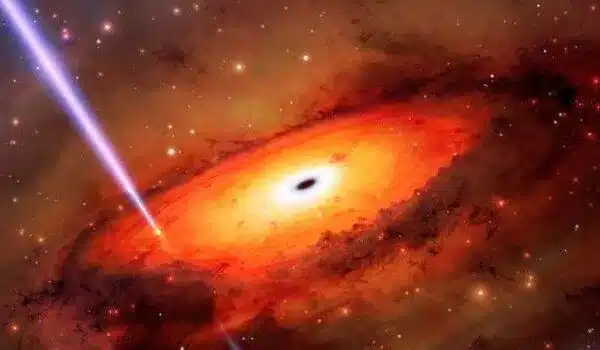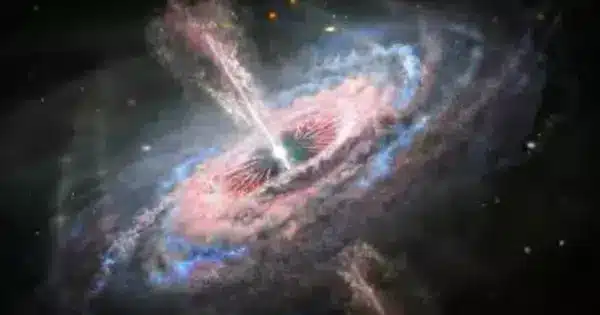Astronomers examining a massive gamma-ray burst may have discovered a previously unknown method of star destruction. Unlike most GRBs, which are caused by exploding massive stars or chance neutron star mergers, astronomers believe this GRB was caused by a collision of stars or stellar remnants in the dense environment surrounding a supermassive black hole at the center of an ancient galaxy.
The International Gemini Observatory has traced a gamma-ray burst to the centre of an ancient galaxy, implying that stars can collide in demolition derbies-style collisions.
Astronomers analyzing a violent gamma-ray burst (GRB) with the Gemini South telescope run by the National Science Foundation’s NOIRLab may have discovered a previously unknown method of star destruction. Unlike most GRBs, which are caused by exploding massive stars or chance neutron star mergers, astronomers believe this GRB was caused by a collision of stars or stellar remnants in the dense environment surrounding a supermassive black hole at the center of an ancient galaxy.
The majority of stars in the Universe die in predictable ways based on their mass. In old age, relatively low-mass stars like our Sun shed their outer layers and decline to become white dwarf stars. In cataclysmic supernova explosions, more massive stars burn hotter and die sooner, resulting in ultradense objects like as neutron stars and black holes. If two such star remnants form a binary system, they may collide at some point. However, new research suggests a long-hypothesized, but never-before-seen, fourth alternative.
Our follow-up observation told us that rather than being a massive star collapsing, the burst was most likely caused by the merger of two compact objects. By pinpointing its location to the center of a previously identified ancient galaxy, we had the first tantalizing evidence of a new pathway for stars to meet their demise.
Andrew Levan
While looking for the origins of a long-duration gamma-ray burst (GRB), astronomers using the Gemini South telescope in Chile, which is part of the International Gemini Observatory run by the National Science Foundation’s NOIRLab, and other telescopes discovered evidence of a demolition derby-like collision of stars or stellar remnants in the chaotic and densely packed region near an ancient galaxy’s supermassive black hole.
“These new results show that stars can meet their demise in some of the densest regions of the Universe where they can be driven to collide,” said Andrew Levan, an astronomer from Radboud University in the Netherlands and the lead author of an article published in the journal Nature Astronomy. This is exciting for understanding how stars die and for answering other questions, such as what unexpected sources might create gravitational waves that we could detect on Earth.”
Ancient galaxies are long past their star-forming prime and would have few, if any, big stars left, which are the primary source of lengthy GRBs. However, their cores are filled with stars and a slew of ultra-dense stellar remnants including white dwarf stars, neutron stars, and black holes. Astronomers have long thought that it would only be a matter of time before two star objects collided to form a GRB in the tumultuous beehive of activity that surrounds a supermassive black hole. However, evidence for such a union has been difficult to come by.

The first indications that such an event had occurred came on October 19, 2019, when NASA’s Neil Gehrels Swift Observatory observed a brilliant burst of gamma rays that lasted just over a minute. Any GRB that lasts more than two seconds is classified as “long.” Such bursts are usually caused by the supernova death of stars with at least ten times the mass of our Sun, but this is not always the case.
To learn more about the GRB’s origins, the researchers used Gemini South to perform long-term investigations of its fading afterglow. The data enabled the astronomers to identify the GRB’s position to a region fewer than 100 light-years from the center of an old galaxy, putting it very close to the galaxy’s supermassive black hole. The researchers also found no evidence of a corresponding supernova, which would leave its imprint on the light studied by Gemini South.
“Our follow-up observation told us that rather than being a massive star collapsing, the burst was most likely caused by the merger of two compact objects,” said Levan. “By pinpointing its location to the center of a previously identified ancient galaxy, we had the first tantalizing evidence of a new pathway for stars to meet their demise.”
In normal galactic environments, the production of long GRBs from colliding stellar remnants such as neutron stars and black holes is thought to be vanishingly rare. The cores of ancient galaxies, however, are anything but normal and there may be a million or more stars crammed into a region just a few light-years across. Such extreme population density may be great enough that occasional stellar collisions can occur, especially under the titanic gravitational influence of a supermassive black hole, which would perturb the motions of stars and send them careening in random directions. Eventually, these wayward stars would intersect and merge, triggering a titanic explosion that could be observed from vast cosmic distances.
Such occurrences may occur on a regular basis in equally dense parts of the Universe but have gone unnoticed until now. One possible explanation is that galactic centers are densely packed with dust and gas, which might hide both the initial flash of the GRB and the following afterglow. This GRB, designated GRB 191019A, may represent an exception, allowing scientists to identify and investigate the burst’s aftereffects.
The researchers want to learn more about these occurrences. Their goal is to link a GRB detection with a comparable gravitational-wave detection, which would reveal more about their true nature and confirm their origins even in the most enigmatic surroundings. The Vera C. Rubin Observatory, when it comes online in 2025, will be invaluable in this kind of research.
“Studying gamma-ray bursts like these is a great example of how the field is really advanced by many facilities working together, from the detection of the GRB, to the discoveries of afterglows and distances with telescopes like Gemini, through to detailed dissection of events with observations across the electromagnetic spectrum,” Levan said.
“These observations add to Gemini’s rich heritage of developing our understanding of stellar evolution,” says Martin Still, program director for the International Gemini Observatory at the National Science Foundation. “The time-sensitive observations are a testament to Gemini’s nimble operations and sensitivity to distant, dynamic events across the Universe.”
















